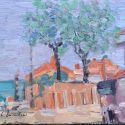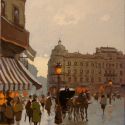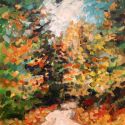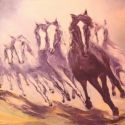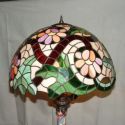A huge poetical talent and a controversial character, Tudor Arghezi is considered one of the greatest Romanian poets, one of the reinventors of Romanian artistic language, but also one of the fiercest and vulgar pamphlet authors in history. Many thought of him as the new great voice in national literature, others considered him an impostor, a fraud, an abomination in the world of poetry, but neither category could afford to ignore him.
Born on May 21st 1880, the future poet Tudor Arhezi was actually named Ion N. Theodorescu, and by all accounts chose his pen name from the old name of the Arges River - Argesis - taken from Hasdeu's dictionary. An early talent, although yet "rough around the edges", Arghezi made his poetical debut in 1896, when he was still a teenager, under the pen name of Ion Theo, in a magazine which was run by Alexandru Macedonski. For a while he was impressed and influenced by Symbolism and the first signs of literary avantgarde, which will make a distinct and long-lasting mark upon his style. In a surprising change of pace, he would spend no less than five years at the Cernica Monastery, but soon abandoned the though of becoming a monk, founded his first magazine and becase close to Gala Galaction and Vasile Demetrius.
Starting with 1905 he travelled to Paris, then to Germany and Switzerland, continued working and writing poetry, and for a short time earned his living as an apprentice to a jeweller. He also visited Italy, only to return to Romania in 1910 and begin a successful career as a poet and nevertheless as a journalist, publishing his works into such magazines as Viata Romaneasca, Teatru, Facla, and others. Not only his articles and poetries were interesting. What was strikingly original and influent was his talent as a pamphlet writer, caustic and harsh, often vulgar and scandalous. It brought him a lot of enemies, but also a lot of admirers. He also made himself known as a competent art critic.
More or less close to writers such as Ion Minulescu, Liviu Rebreanu, Victor Eftimiu or Eugen Lovinescu, also a friend of painters such Iosif Iser, Steriadi and many others, Arghezi was already known as a good poet and a fierce journalist, but the real success will begin only after World War I. At first, it seemed all was going bad for hims, as in 1918 - 1919 he was detained at the Vacaresti prison - together with other 11 writers and journalists - because of his collaboration with the German occupants. For others it could have meant the end of the career, for Arghezi it was just another beginning. In 1927, after a long period of work, he managed to publish his debut poetry volume, "Cuvinte potrivite", and also founded his small newspaper, "Bilete de papagal". Both of these will play a key-role in the history of Romanian literature and journalism, although at that time it seemed just the serious game of a controversial writer.
It was just the start, for over the following years Tudor Arghezi will publish several volumes of poetry and prose, articles, reviews, books for children, magazines and so on.. His poetry volumes were surprisingly successful from the very beginning, and titles such as "Flori de mucigai", "Poarta neagra", Versuri de seara" were highly popular. Much to his generation's surprise, the poet also proved to be a very good author of novels, and published several, the most successful being "Cimitirul Buna-Vestire", a strange and very poetical composition.
During World War 2 he was once again arrested, this time due to a pamphle directed at the German ambassador von Kilinger, and the poet would spend a year at a prison camp in Tg Jiu, from 1943 to 1944. The Communist era, which will change the artistic world, would also mark the beginning of the most severe persecutions in the life and career of the writer. In 1948 a violent series of articles, published by Sorin Toma in Scanteia, the PRC newspaper, signalled the start of a violent denigration campaign, directed against Arghezi. Titled "Poezia putrefactiei sau putrefactia poeziei", it literally dismantled Arghezi as a poet and writer, placing him in a category of abomination and depravation, recommended that he was forbidden to publish. Forever. It happened quickly, and many of his former friends didn't hesitate to turn against him. Hurtful articles, strong insults, his volumes confiscated and destroyed, taken out of public libraries, his signature dissapearing from the pages of magazines and newspapers. It was the end for Arghezi, and for a long while he had to deppend on selling cherries from his own garden, to make ends meet. It seemed just an anecdote, it was a tragic moment in the life of the poet. At least he wasn't the only artist forbidden in the "glorious new regime", and at least he wasn't imprisoned.
The radical shift in the authorities' atituted towards him came after 1952, when the poet was slowly "taken back" into the mainstream literature, after he made the pact and started publishing in Communist magazines and newspapers, and even began writing violent pamphlets much to the liking of the new regime. Many accused him of making a pact with the Devil, others that he was in it just for the many, and had no shame into attacking his former friends. He once again began publishing his new and older works, although often censorship had a hard word to say, he received prizes and awars, was celebrated as a National Poet. He began earning large amounts of money for his articles and poems, didn't hesitate to turn into often shocking propaganda images, attacked all that was against the New Order. Many were dissilusioned, others hated him. Yet most remembered the real poet and journalist and writer. Who had to make this compromise to survive. As an artist and human being.
Tudor Arghezi passed away on July 14th 1967, in Bucharest, and was burried in the courtyard of his house on Str Martisor, today a memorial museum, one of the best in Bucharest.
October 2008



